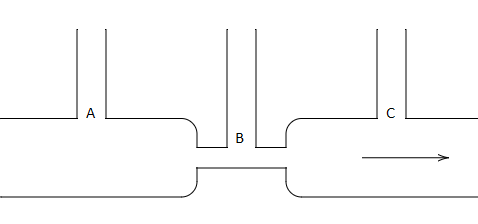
In the figure below is shown the flow of liquid through a horizontal pipe. Three tubes $A$, $B$ and $C$ are connected to the pipe. The radii of the tubes $A$, $B$ and $C$ at the junction are respectively $2\,cm$, $1\,cm$ and $2\,cm$. It can be said that the:

(A) The height of the liquid in the tube $A$ is maximum
(B) The height of the liquid in the tube $A$ and $B$ is the same
(C) The height of the liquid in all the three tubes is the same
(D) The height of the liquid in the tube $A$ and $C$ is the same.
Answer
219.6k+ views
Hint: By using the theory of the Bernoulli’s theorem and the venturi meter concepts, the height of the liquid in the pipe $A$, pipe $B$ and pipe $C$ are determined. In venturi meters the height is determined by the relation of the pressure in the pipe and density of the liquids.
Complete step by step solution:
Given that,
The radius of the pipe $A$, ${r_A} = 2\,cm$
The radius of the pipe $B$, ${r_B} = 1\,cm$
The radius of the pipe $C$, ${r_C} = 2\,cm$
Bernoulli’s theorem:
Bernoulli’s theorem states that the total mechanical energy of the fluid flowing having the energy associated with fluid pressure, the gravitational potential energy of elevation, and the kinetic energy of fluid motion will remain constant.
Assuming that the pressure of the liquid is flowing near the junction of the pipe $A$ and the liquid is flowing near the junction of the pipe $C$ are the same pressure. Because the diameter of the horizontal pipe is the same in both the junctions.
The pressure is different near the junction of the pipe $B$, because the diameter of the horizontal pipe near the junction of pipe $B$ is different from the diameter of the horizontal pipe near the junction of the pipe $A$ and pipe $C$. The height of the liquid in the venturi meter depends on the pressure of the fluid flowing in the horizontal pipe.
So, the pressure of the pipe $A$ and the pressure of the pipe $C$ is the same, then the height of the liquid in the tube $A$ and the height of the liquid in the tube $C$ is the same.
Hence, the option (D) is the correct answer.
Note: Near the junction of the pipe $B$, the pressure is greater than the pressure of the liquid near the junction of the pipe $A$ and the junction of the pipe $C$. Due to the high pressure and the small diameter of the pipe $B$, the height of the liquid in the pipe $B$ is little small when compared to the height of the liquid in the pipe $A$ and pipe $C$.
Complete step by step solution:
Given that,
The radius of the pipe $A$, ${r_A} = 2\,cm$
The radius of the pipe $B$, ${r_B} = 1\,cm$
The radius of the pipe $C$, ${r_C} = 2\,cm$
Bernoulli’s theorem:
Bernoulli’s theorem states that the total mechanical energy of the fluid flowing having the energy associated with fluid pressure, the gravitational potential energy of elevation, and the kinetic energy of fluid motion will remain constant.
Assuming that the pressure of the liquid is flowing near the junction of the pipe $A$ and the liquid is flowing near the junction of the pipe $C$ are the same pressure. Because the diameter of the horizontal pipe is the same in both the junctions.
The pressure is different near the junction of the pipe $B$, because the diameter of the horizontal pipe near the junction of pipe $B$ is different from the diameter of the horizontal pipe near the junction of the pipe $A$ and pipe $C$. The height of the liquid in the venturi meter depends on the pressure of the fluid flowing in the horizontal pipe.
So, the pressure of the pipe $A$ and the pressure of the pipe $C$ is the same, then the height of the liquid in the tube $A$ and the height of the liquid in the tube $C$ is the same.
Hence, the option (D) is the correct answer.
Note: Near the junction of the pipe $B$, the pressure is greater than the pressure of the liquid near the junction of the pipe $A$ and the junction of the pipe $C$. Due to the high pressure and the small diameter of the pipe $B$, the height of the liquid in the pipe $B$ is little small when compared to the height of the liquid in the pipe $A$ and pipe $C$.
Recently Updated Pages
Electricity and Magnetism Explained: Key Concepts & Applications

JEE Energetics Important Concepts and Tips for Exam Preparation

JEE Isolation, Preparation and Properties of Non-metals Important Concepts and Tips for Exam Preparation

JEE Main 2021 July 25 Shift 1 Question Paper with Answer Key

JEE Main 2021 July 22 Shift 2 Question Paper with Answer Key

States of Matter Chapter For JEE Main Chemistry

Trending doubts
JEE Main 2026: Application Form Open, Exam Dates, Syllabus, Eligibility & Question Papers

Understanding Uniform Acceleration in Physics

Derivation of Equation of Trajectory Explained for Students

Hybridisation in Chemistry – Concept, Types & Applications

Understanding the Angle of Deviation in a Prism

Understanding Collisions: Types and Examples for Students

Other Pages
JEE Advanced Marks vs Ranks 2025: Understanding Category-wise Qualifying Marks and Previous Year Cut-offs

Units And Measurements Class 11 Physics Chapter 1 CBSE Notes - 2025-26

NCERT Solutions For Class 11 Physics Chapter 8 Mechanical Properties Of Solids

Motion in a Straight Line Class 11 Physics Chapter 2 CBSE Notes - 2025-26

NCERT Solutions for Class 11 Physics Chapter 7 Gravitation 2025-26

Mechanical Properties of Fluids Class 11 Physics Chapter 9 CBSE Notes - 2025-26




